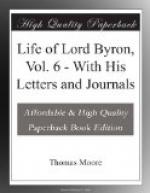[Footnote 1: I will submit to Mr. Bowles’s own judgment a passage from another poem of Cowper’s, to be compared with the same writer’s Sylvan Sampler. In the lines to Mary,—
“Thy needles, once a shining store,
For my sake restless heretofore,
Now rust disused, and shine no more,
My Mary,”
contain a simple, household, “indoor,” artificial, and ordinary image; I refer Mr. Bowles to the stanza, and ask if these three lines about “needles” are not worth all the boasted twaddling about trees, so triumphantly re-quoted? and yet, in fact, what do they convey? A homely collection of images and ideas, associated with the darning of stockings, and the hemming of shirts, and the mending of breeches; but will any one deny that they are eminently poetical and pathetic as addressed by Cowper to his nurse? The trash of trees reminds me of a saying of Sheridan’s. Soon after the “Rejected Address” scene in 1812, I met Sheridan. In the course of dinner, he said, “Lord Byron, did you know that, amongst the writers of addresses, was Whitbread himself?” I answered by an enquiry of what sort of an address he had made. “Of that,” replied Sheridan, “I remember little, except that there was a phoenix in it.”—“A phoenix!! Well, how did he describe it?”—“Like a poulterer,” answered Sheridan: “it was green, and yellow, and red, and blue: he did not let us off for a single feather.” And just such as this poulterer’s account of a phoenix is Cowper’s stick-picker’s detail of a wood, with all its petty minutiae of this, that, and the other.]
And now that we have heard the Catholic repreached with envy, duplicity, licentiousness, avarice—what was the Calvinist? He attempted the most atrocious of crimes in the Christian code, viz. suicide—and why? because he was to be examined whether he was fit for an office which he seems to wish to have made a sinecure. His connection with Mrs. Unwin was pure enough, for the old lady was devout, and he was deranged; but why then is the infirm and then elderly




